In this article: Learn every thing you need to know about farm fencing options, with a full guide on posts, wire, and gates!
When it comes to the farm there are many, many fencing options to consider. How do you know what option to choose? First you need to consider what your fencing needs are.
This site contains affiliate links. If you make a purchase using one of these links, I may earn a commission. Please see my disclosure page for more information about cookies collected and our privacy policy.
Do you need to keep an animal in? Do you want to keep animals out? How much is your budget? How quickly do you need the fence in place? Is it important for the fence to be aesthetically pleasing?
Once you have in mind what you are looking for you can begin to narrow down your fencing options to the one that is right for you.
The Ultimate Guide to Farm Fencing Options
Fence Post Options
Fence posts can be simple or they can be fancy. From metal t-posts to wooden locust posts, each option has its pros and cons. Here are a few of the options to consider when purchasing fence posts.
Metal T-posts Fence Posts:
T-posts come in a variety of sizes from 4 ft to 8ft. They usually come in bunches of 5 and are easy to find at your local farm store.
Pros:
- T-posts are easy and quick to install. And require only a t-post driver or even just a sledge hammer.
- Often less expensive than wood posts
- Reusable, moveable and long lasting
Cons:
- Not as aesthetically pleasing as wood posts
- They require the additional purchase of clips or insulators in order to attach your fencing.
The Bottom Line:
The average cost for a single t-post is $3-$4 (depending on your area). This is significantly cheaper than store bought wood posts. They are easier to handle than wood posts and can be used with all different types of fencing.
A good, cheap fence post option for someone looking to get a fence up in a short amount of time and not break the bank.
Store Bought/Treated Wood Fence Posts:
Treated wood fence posts are usually round posts that come in sizes ranging from 6-8ft. They are easily found at your local farm supply or home improvement store.
Pros:
- Uniform shape and size
- Posts are resistant to rot, which increases their lifespan
Cons:
- Most posts are treated with chemicals that are not healthy for people or the soil
- Heavy and cumbersome to carry
- Requires digging 1-2 foot holes in order to support the posts
- More expensive than t-posts
The Bottom Line:
Store bought treated posts cost about $8-10 per post and can be found almost anywhere- from your local farm store to large home improvement chains such as Home Depot.
Due to their uniformity they are more aesthetically pleasing than other fence post styles. I personally do not recommend these posts due to the chemical treatments used on them.
Locust Fence Posts:
Split locust fence posts are a way to get wooden fence posts without the chemical treatment. You can usually find them locally ranging from 6-8 ft and sometimes longer.
Pros:
- Locust posts are naturally resistant to rot and require no chemical treatment
- Posts have a long lifespan
- They have a very natural, rustic look
Cons:
- Locust posts are not uniform in shape, size or looks. Depending on your personality, this can either be a good or bad thing
- They are harder to find
- The cost is usually higher than metal posts, but usually less than treated, store bought posts
- Like other wood posts they are heavy and require a deep hole to secure them in the ground
The Bottom Line:
Locust fence posts are a way to bring natural beauty to your fence. They can be harder to find and are best found locally through farms, sawmills or even your local Craigslist listings.
Cost will vary greatly by area and based on the size of your posts. We recently purchased local, 7 ft locust fence posts for $3.50 each, making them less expensive than t-posts.
This is my favorite fencing option for posts. They are not as cheap as t-posts but they make a nice, strong, fence for livestock.
Step-in Fence Posts:
Step-in posts are light-weight posts used primarily for temporary pastures. They are most often made of fiberglass or polypropylene.
Pros:
- Inexpensive with no extra materials required to secure your wire to the posts
- Very quick to install, using nothing more than your foot to push them into the ground
- Good for dividing pastures
Cons:
- Due to their lightweight nature they cannot be used for large animals or animals that will test a fence
- Shorter lifespan
- Can only be used with electric wire, tape or netting
The Bottom Line:
Step-in posts are an inexpensive fencing option that allows you to build a fence fast. They are best used for dividing or temporary pastures.
They are readily available at your local farm or home improvement store and usually cost between $2-3 each.
Related Reading: 6 Fencing Mistakes That Are Costing You Time and Money
Wire Fencing Options:
Just like with your posts, you have a lot of different choices when it comes to wire fencing.
This is where you need to decide the purpose of your fence- what do you want to keep in our out? Not all fence wire options are created equal and knowing the answer can help you decided what is best for your farm needs.
Welded Wire Fencing
About:
Welded wire fencing is constructed by welding the connections between the horizontal and vertical wires of the fence. It can be purchased in a variety of gauges and most commonly comes with 2″x4″ mesh openings in heights between 3 ft and 5ft.
Use:
Welded wire fencing is not quite as strong as its woven wire counterpart, so it is best used with animals who will not lean or stand on the fence. It is a great option for a chicken run or garden fence as well as used as a guard to protect trees from deer or livestock.
The Bottom Line:
Welded wire fence is typically less a expensive fencing option than woven wire and can be found at most farm or home improvement stores in rolls of 5oft to 300ft.
It is less durable and can be harder to stretch than woven wire. It can also be harder, or impossible, to fix if the wire welds break.
Woven Wire Fencing
About:
Woven wire fencing is constructed with a wire knot at the junctions of the horizontal and vertical wires. It comes in lengths from 50ft to 330 ft and in a variety of mesh opening sizes and heights.
Use:
Woven wire fence is a durable, long lasting fencing option for livestock. Depending on your needs, you can choose “goat fence” with smaller openings and strong construction to prevent animals from putting their heads through and to withstand impact from the animal leaning or standing on the fence.
Larger animals or those who don’t stress a fence can have wider openings.
The Bottom Line:
Though it tends to be more expensive fencing option than welded wire, when it comes to durability, woven wire fences are the way to go when it comes to fencing in livestock. It is easier to stretch and easier to fix.
If you are fencing in a very large area you might want to consider other options such as electric or barbed wire.
This is the best fencing for goats.
Field Fence Wire
About:
Field fence is a specific type of woven wire fence. It typically comes in rolls of about 330ft and is a much less expensive fencing option than other types of woven wire fences.
The mesh spacing is variable, ranging from 3 inches to 7 inches, with the bottom spaces being closer together and the top farther apart.
Use:
Field fence is best for low impact animals or if you need a secure, full fence for a large area. It is great for keeping deer out of a garden or for fencing a dog run.
The Bottom Line:
Field fence is an economical way to fence a large area. It is readily available online, through your local farm supply store or from large chain stores. It is easy to stretch and can handle changes in terrain.
On our farm we have field fence around our garden area.
Barbed Wire Fencing
About:
Barbed wire fencing consists of 2 strands of wire that have been twisted together, with barbs placed every 3-5 inches throughout the length of the fence.
Use:
Barbed wire fencing is best used for large animals such as cattle or bison. It cannot be used safely with animals such as goats, sheep, llamas or alpacas.
It can also be used as a perimeter fence for you property or in conjunction with a woven or welded wire fence. Most barbed wire fences are made up of 5 strands of wire.
The Bottom Line:
Barbed wire is an inexpensive fencing option when you want to fence in a large pasture for cattle.
It is strong, long lasting and easy to repair. With barbed wire you can also place your fence posts much farther apart, reducing the overall cost of the fence even more.
Related Reading: The Best Fencing for Goats
Electric Wire Fencing
About:
An electric fence is made up of multiple strands of high tensile wire. It requires the additional use of a fence charger, grounding rods and insulators. Most electric fences consist of 4-5 strands of wire.
Use:
Electric fencing is a durable, long lasting and flexible way to build a fence. It is a good option for goats, sheep, pigs, cattle, horses and llama. They are a good deterrent for keeping predators out as well as your livestock in.
Keep in mind that, an electric fence is only a psychological barrier and may not be the best option for very head strong animals- such as a buck in rut.
Electric fencing can be used as a permanent fence, temporary fence, or to divide pasture.
The Bottom Line:
Electric fencing is a very inexpensive fencing option when you want to fence in a large variety of animals over a large piece of land. It is easy to build and can be used in conjunction with wood or metal fence posts.
Like with barbed wire, your fence posts can be placed much farther apart than with woven or welded wire. We use electric for our female dairy goats and our alpacas.
Read more about how we use Electric Fencing for Goats.
Fence Gate Options:
When it comes to gates, you don’t have quite as many choices to choose from. It comes down to looks, cost, and convenience when choosing a gate.
Tube Gate
Tube gates come in a variety of sizes from a small 3ft walk-through gate that is perfect for a garden or yard to a 16ft drive-through gate that will allow tractors, large trucks or a large number of livestock pass through easily.
Tube gates are durable, long lasting and are easy to install on your wooden fence posts.
They are also available with panels to prevent smaller animals, such as kids or lambs, to jump through. Tube gates can be expensive, usually running between $50 and $200.
Wooden Gate
Wooden gates can be custom built to your size and tastes.
They can add a beautiful finish to a wooden-post fence as well. They are easier to build yourself from reclaimed wood.
We even use a wooden pallet as a gate to our alpaca yard.
Gate Handles
Gate handles are a low cost way to put a gate in an electric or barbed wire fence. They can be a quick and inexpensive way to place a gate in an area that will not get a lot of traffic.
Of course these are not your only fencing options. There is also a split-rail wooden fence, cattle panels, chicken wire, and I’ve even seen a fence made completely out of recycled wooden pallets.
But the fence options I listed are the most common used around the farm or homestead. It seems like fencing on the homestead is a never ending project. What fence will you build next?

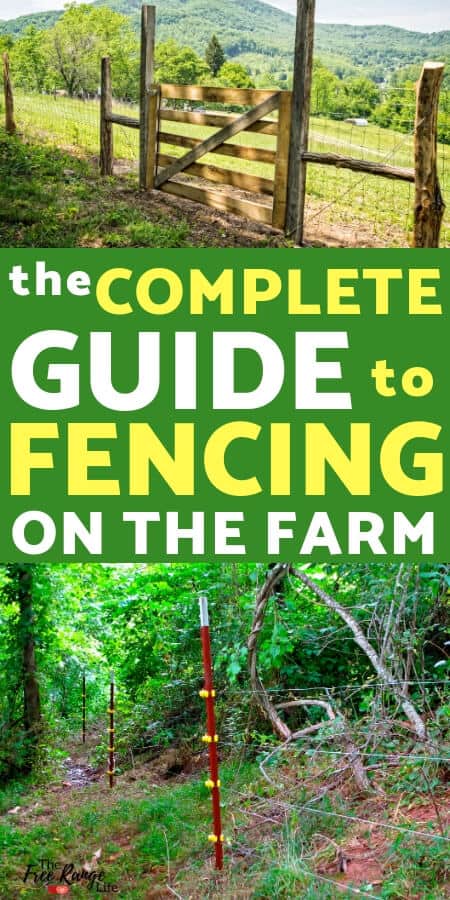
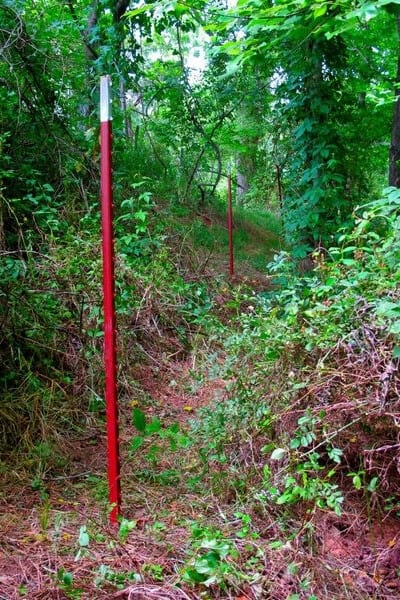
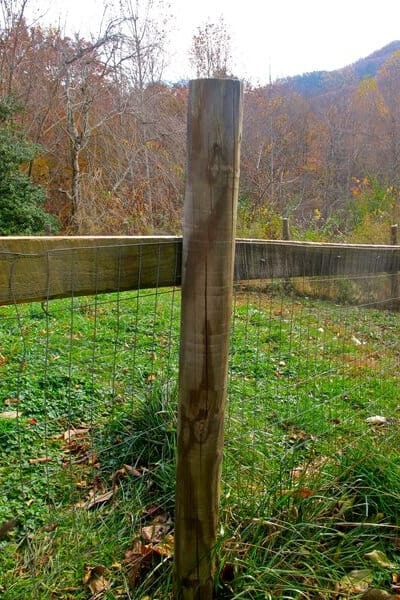
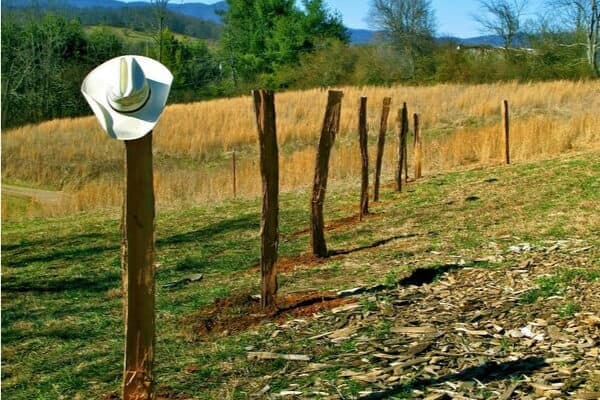
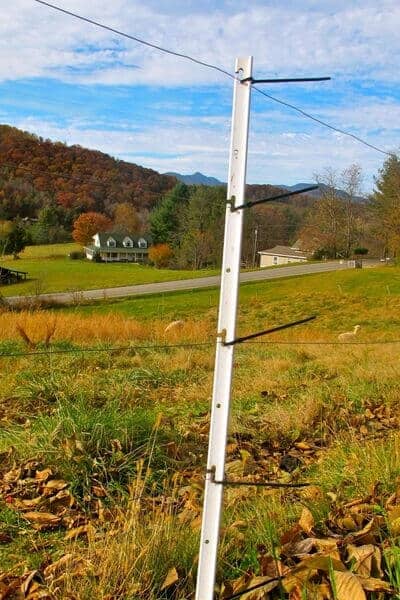
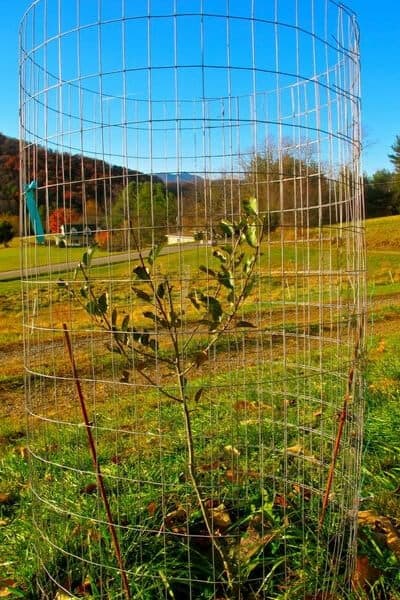
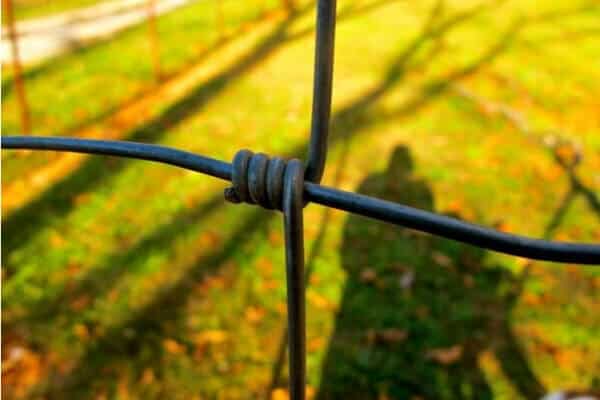
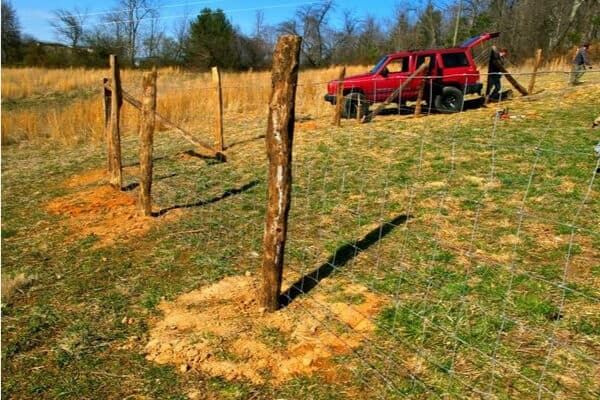
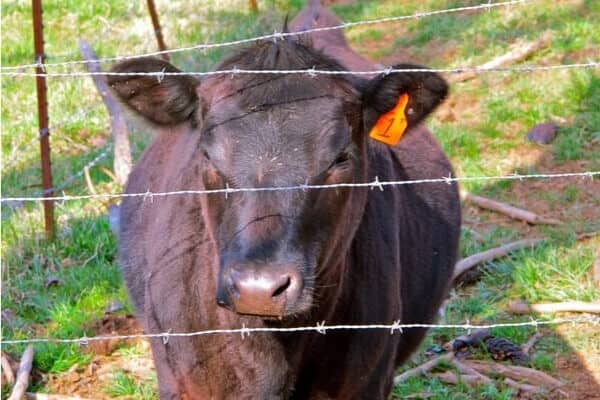
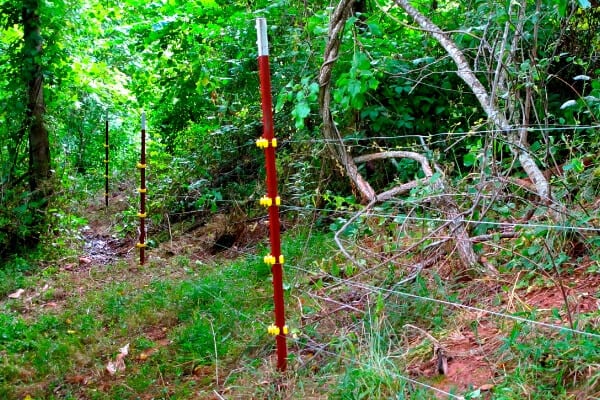
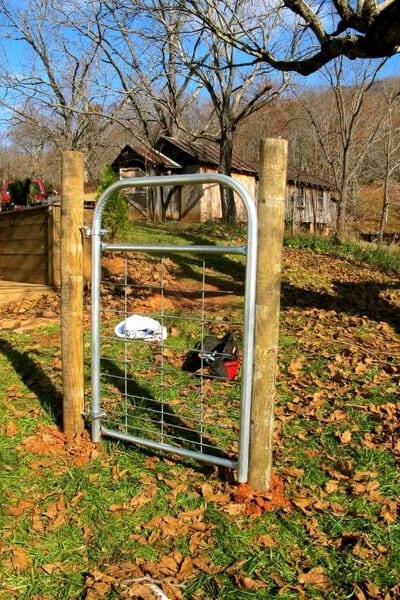
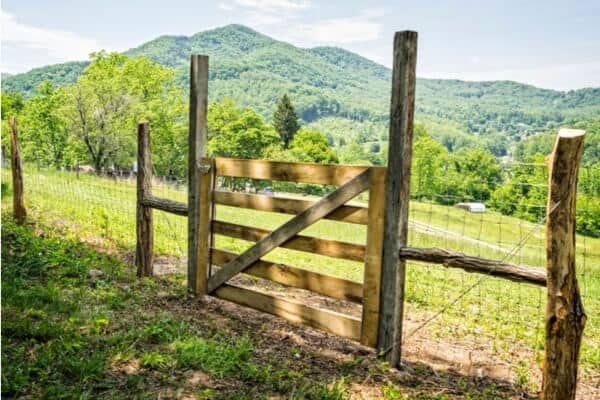
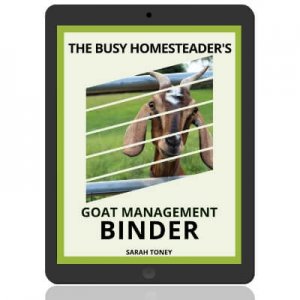
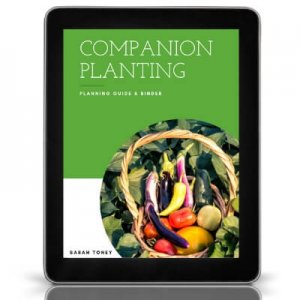
Very helpful. Thank you!
Very informative! I’m glad you posted this on The Rural Wisdom and Know How Blog Hop.
Please do NOT use barbed wire for horse fencing. The money saved on fence will be lost when a horse runs into it or gets tangled in it. Vet bills are exceedingly expensive. “An ounce of prevention is worth a pound of cure.”
I almost lost a horse to barbed wire. He got caught in it and the barbed wire tore the flesh all the way down to the bone on two legs. He recovered but It took many months. Replacing the barbed wire was the first thing I did when I purchased my new property.
Been there… done that… nearly totally severed her front hoof!.
DONT GO THERE 💰💰💰
Very good job. Thanks you for sharing on Rural Wisdom and Know How. Hope to see you again next week.
I love this post! Lots of great information for anyone looking into putting some fencing on their farm. Thanks for sharing with us over at the Homeacre Hop! Please join us again soon!
Mary :)
Wow! Thanks for the extensive information! I’ll definitely be bookmarking this page for future reference!! :D
This is a great & very informative post! It came in handy too as we’re looking at all the options for fencing in some animals housing as well as around the property.
Thanks for this! As we gear up for our 2014 farm-expansion we’re looking at fencing options for the goats we intend to invest in. Nice post!
Thank you for posting this! We are about to put up a fence extension for our goats and llamas. We used the pressure treated wooden posts to make our first fence, but I think we will go with the metal t-posts this time around so we don’t have to deal with the auger. Plus I like that they are less permanent. Thanks again! :)
Right now I’m ordering the materials for my ranch fence thanks to what you suggested in your excellent research. Please continue publishing, I will continue using your expertice.
Regards
Rico
We wanted the welded wire fencing and wooden posts for our fence but couldn’t afford the steep price for 4×4 posts. So we looked at landscape timers which ran about $4 per post, then used deck boards for the cross boards. Both cheaper options than the normal wooden fence materials.
Thank you for posting this! This was incredibly helpful!
Hi, Can you tell me where you found that gate? Is is a 3-foot gate? or is it just the angle of the picture that makes it look smaller? :)
Yes, it’s just a 3 ft gate…from our local farm store
can you tell me the pros and cons about using 16′ cattle panels? I have about 1300′ to fence and I am going to use a combination of t posts and wood posts. Fence panels seem like they would be easier to use.
The main pro would be, as you said, they are easier to use. They are sturdy and there is no stretching or pulling tight involved. The major con would be cost. Compared to other fencing options this would be one of the more expensive ways to go. We only use cattle panels in small areas or in areas that need that sturdier fencing material.
while growing up on a farm & having to build fences I suggest that you stay away from locust post because when the post dries out /cures you will not be able to drive a staple in it to fasten the wire without bending the staple .we have some here on the farm that have been in place 60+ years but are not usable. I suggest metal post because when driven in the ground they are very stable. when you dig a hole for a wooden post you have to pack the dirt very tightly & when it rains you can still move the post.
Thanks for such an informative article!
Thank tou for this article. We are planning to add a fence soon and this truly is a thorough guide for fencing.
very much appreicated!!
This is an awesome read. Thanks for sharing this to us!
Thank you!! I’ve been looking into my options for fencing lately, and most of the articles I’ve found haven’t been very thorough or easy to follow. You rock! I recently wrote an article about fencing for deer, but it’s different when you’re looking for ways to keep livestock IN.
How tall of a fence do you Rocco end for Nigerian dwarf goats
Any suggestions on fencing for crossing creeks and streams? Also, best options for undulating / uneven terrain? Thanks!
We use electric on our hilly terrain and over creeks and streams as well. What you use would depend on what you are fencing in/out
Thank you for this article. We are planning to add a fence soon and this truly is a thorough guide for fencing.
I am a fan of using barbed wire or electric fencing. Like the article says, electric fencing is good if you do not have any headstrong animals. We have used it for dogs, cattle, and goats and it worked just fine. Previously we had a barbed wire fence and it was perfect for our cattle, but not so much for the goats. Thanks for the very informative article! It was a great read.
Man, I wish I had seen this article when I first got goats! It’s full of so much great info. Love how you have pros/cons of each.
Our fencing has a combo of the metal ts and the round treated wooden poles at corners/bends. Has held firm against a small goats this far 🤣
This article is amazing! And I’ll save it for later and any friends that need help.
Thanks so much!
Becc,
Do you do additional wood support posts at any corners/intersections of fence? We are going to be doing the combination this year for the sheep/goats and was wondering how strong those areas need to be.
Also, what type of wire do you use? I’m thinking field wire for the goats but am unsure if it is strong enough.
Fencing for horses is so much easier!
Thank you!
Do this fencing have in the Philippines?
Thanks so much for this! Some parts of this are still a mystery to me, and it’s good to have a guide to go back to.
What is your opinion of using field fencing for small goats (pygmy/miniature breeds)?
Getting a couple of pets and refencing part of the backyard….just wondering if field fence would be appropriate.
Thanks!
Very good idea. I will now have to shop for necessary stuff after reading this article! thanks to you.
Great info! I am just starting my homestead and slowly growing. I have chickens in a run. This year want to add goats, a few sheep, 1-2 cows and in the future 2 horses. I have NO IDEA how to proceed to plan fencing for this. Does anyone help with homestead planning?